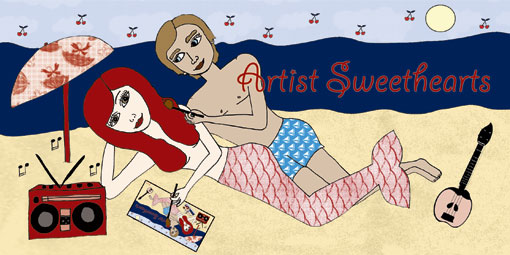
Kunst und Liebe, Liebe und Kunst... Was, wenn beide Partner:innen Künstler:innen sind?
Die Ausstellung zeigt exemplarisch die Werke unterschiedlicher Künstlerpärchen beieinander und versucht eine Vergleichbarkeit zwischen den Arbeiten innerhalb einer Lebens-/Liebesbeziehung und zwischen den jeweiligen individuellen Partnerschaften an sich herzustellen. Wo sind Gemeinsamkeiten und wo Unterschiede in den Kunstwerken zu entdecken? Gibt es sichtbare Beeinflussungen und/oder Interessengleichheiten in den Beziehungen oder erscheinen die jeweiligen Positionen vollkommen gegensätzlich?


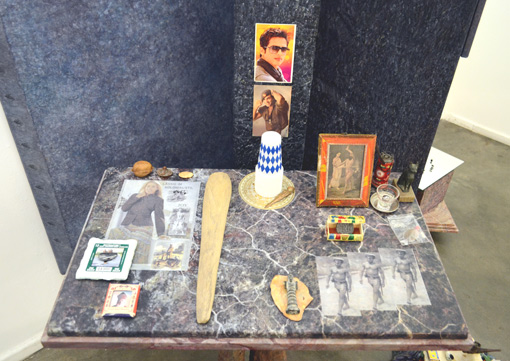
The artistic strategy of Michel Aniol is based on a widespread engagement in various manifestations, visual languages and philosophies of different cultures. In particular, he investigates the developement of a new global culture that has evolved in the course of globalisation and consistently generated new forms of expression. On various travels often taking several months, Aniol set up a collection of base and archive materials by gathering objects and observing and documenting different living environments. This source material is finally concentrated and rearranged in extensive spatial works. Therein, he examines the conjuncture between archaic ways of living and corresponding culture models in contrast to the expanding western lifestyle of internet, mobility, internationality and commercialization and questions the relation of the used components regarding their origin, functionality and statement. By redefining miscellaneous contents Aniol creates new contexts of meaning on the interface between old and contemporary cultures and unknown and common ways of living and reveals hidden processes under the surface.
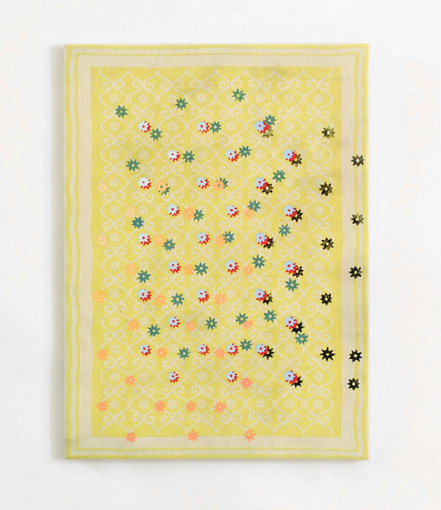
Meike Kuhnerts approach of work is based on painting, which reappears in questioning the concepts of illusion space, perception, objectness and the status of a painting as legitimized form of art. A fundamental aspect of her work is translating objects into the visual language of paintings. Kuhnert uses fabric, which she relieves from its ordinary purpose by framing the material on stretchers. By painted imitations of the pattern or by direct usage as canvas the cloth is transformed into a painting. The ingredients of which a painting is composed play an essential role in fulfilling the process of transformation. New combination possibilities surface mostly planned but also in progress of work.
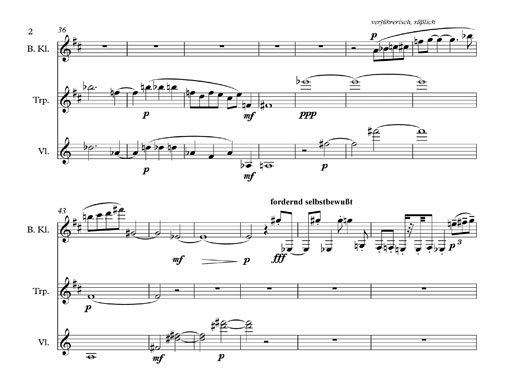
About the compostion „Central Heating“ for the exhibtion Sweethearts:
„Zentralheizung“ (Central Heating) is a compostion for radiator, bass clarinet in b, trumpet in b and violin. The spiritual abyss, desire and patterns of behaviour are reflected in it. It's a synonym for human attributes and projections as well as human longing for the satisfaction of human basic needs. The musical part of the compostion has been developed with regard to its interaction with the shown object and vice versa.
Are these now installations for pieces of music? Concerts for objects? Or is it a performance? The object carves the music, the music dematerialises the object. The piece of music can only reveal its full expression in combination with the object, and also the other way around: the object needs the music.
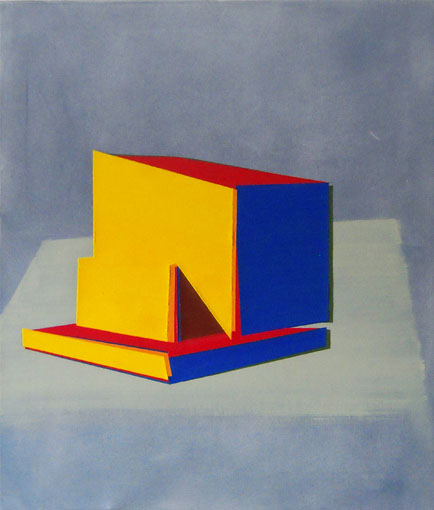
A lazed ground keeps the structure of the canvas visible and present. It's painting, no illusion.
An imbedded basis is floating.
With thin paint and quick brush strokes, a vague shape, like a piece of material, something solid is anchored in the image space.
It's the space for the objekt as plane which is fixed without shadows.
Endlessly free, but at the same time rigid as a wall; an inexorably immobile, tragic projection screen. Being there for everybody and everything, always clement, constantly demanding. That's the base, where the object with it's thick, paste-like paint, it's apparent plasticity made of primary colour fields sortet in shadow and light sides, meets the concrete plane. The colourful planes are stapled. They lie; the object stands, from now on with determination? It has the rough shape of a socle. Because of the distorted proportions, kinks, extensions and shortenings it's shape remains it's function.- It's the plane.
In his paintings, sound installations and film projects Klaus Erich Dietl samples the elements of our daily media coverage, cuts them up and recombines them with other disparate graphical material. Doing this he takes control of the essential instruments of manipulation and plays them off against each other. Within collage and montage he sees the chance of undermining precise and predetermined sequences of associations, which constitute the manipulative nature of the media.
Dietl is not only a critical mind, but also a joyful cooperator.
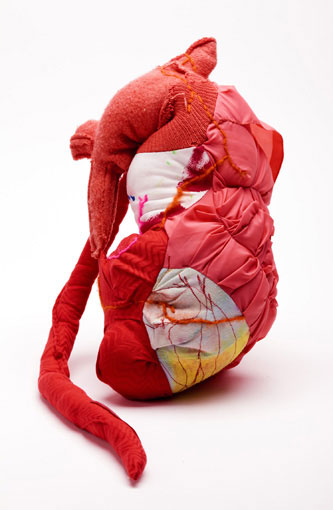
Stephanie Müller is a visual artist and sociological researcher with a fierce love for experiments and improvisation. At the “Künstlerhaus” she presents “The Golden Age of Collapse”. A modular room installation stuffed with textile diseases to cuddle up with such as “Lovesickness To Go”. Stephanie develops interactive performances, sound and video installations. Her main artistic focus is on queer identities and subversive strategies for undermining social control and exclusion.
She tackles unwanted clothing, pins them down and cuts them up, transforming them into textile sculptures and wearable objects.
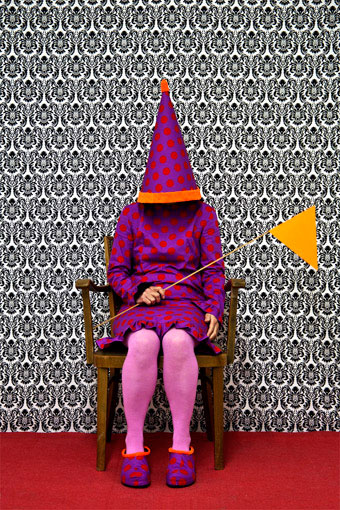
With her installations, sculptures and photographs, Dutch artist Guda Koster transforms the human body and attaches a new identity to her characters or to herself, using clothing as the main visual art form, patterns and colours to create surreal stories.
It is the outfit that defines daily life, our social position, the interaction with others and how we see ourselves. Often exaggerated, with humorous twists, reality is distorted or, better said, cleverly organized into codes and meanings which we can unriddle by focusing on the setting or the fabrics usually sewed by the artist herself.
The illusion and contrast between what is visible and what is invisible is also something that Guda Koster likes to play with. The impossibility of seeing the face of the subjects, covered with small houses, geometric shapes or certain burdens of social or religious nature, erases the limits between man and context, raises the mystery and appetite to learn more, offering the work an universal value.
(Andreea Cazan, Founder of The re:art)
The works of Frans van Tartwijk are not easily caught in a few sentences. His figures, which are painted on paper, do have similarities. They are done in rapid and striking strokes. They express discomfort and make the viewer feel uneasy. They are physical, repulsive at times and they yo-yo between being violent or simply clumsy. Sometimes they are reduced to nothing more than flesh and colour: like that huge belly, towering above huge underpants, blocking the view of the rest of the figure. They are, so to say, on the edges of experience. How should the viewer interpret his work? Van Tartwijk is focused on the most embarrassing moments in life. Like being naked, just wearing socks. Wrestling figures, with their legs in strange angles. Drunken dancing nudes. Heads, ostensibly penetrating a wall. These are scenes from a dream theatre, both humorous and painful. The artist touches on themes like violence, death and life as a theatrical performance. Inge Pollet
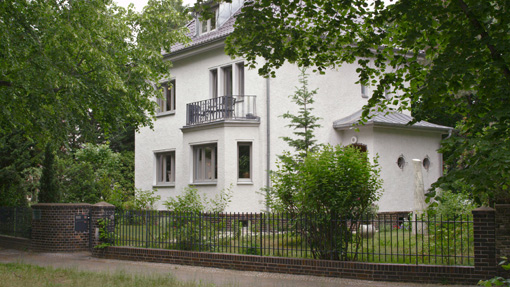
The work Städtchen is about the structures and demarcation of accessibility in public spaces. In a district of Berlin, men in uniforms guard a sealed classical building and escort a passer through the streets. A factual text tells of the situation within the closed area, which can be entered only by permit. Still images portray peaceful town houses, modern and restored buildings surrounded by parking strips. The sound reinforced the idyllic impression. With the help of documentary representation method and Reanactment the film tells the story of the place fragmentary, but does not explain in detail.
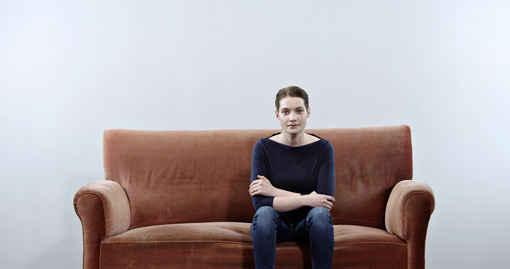
A woman is sitting on a couch while focusing her iron view into the camera
and suddenly starts to talk. Out of her grows a canny and calm monologue
that manifests her world of thoughts and ideas. The at first independently
created monologue starts to get tangled up into contradictions, torn
between different views and ideologies. It is a result of phrases taken
out from different commercials that were combined into a continuously
ongoing monologue. The monologue turns out to be commanded and
alienated by advertisement.
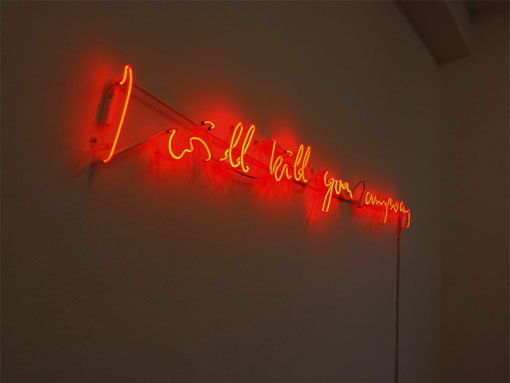
Susanne Kutter is interested in narrative constructions of visual art and often concentrates on a female perspective of the traditional western society. Her work deals with themes of loss, destructed security, shrinking level of protection of privacy and general disappearance of binding social and cultural standards. She combines apparently idyllic pictures with terrifying catastrophic scenarios. This stylistic technique of irony and comicality creates an ambiguous, but at the same time visually poetic atmosphere.
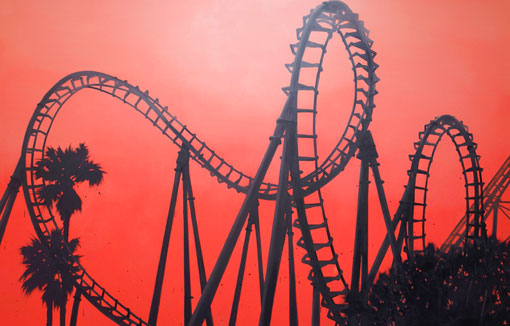
Blown up larger than life or rendered in miniature, tragic figures of cinema history, ghostly androgynous beings, scurrilous vehicles, assorted packaging materials and puzzlingly configured arrangements generate a nebulous medley of colour that is held together by the impression of a common painterly necessity intrinsic to each of the depicted objects. But in this, ornamentally sculptural and minimally flat pictorial data intermingle, lending the motifs a compact yet plausible presence lodged somewhere between ephemerality and permanence, between abstraction and figuration; at the same time, they inject these representations with an endearingly sentimental and emotionally touching quality that lingers long after the initial surprise prompted by the very way they are made. But even if his artistic procedure is the same throughout, this should not be confused with mechanical strategic conjugation, an artistic approach which, as we know, all too often aims simply to elicit superficial effects before descending into tedious routine. Rather, what captivates in his work is precisely the seemingly experimental but meticulously calculated balance between depiction, format, image surface and choice of media, a constellation that constantly reassesses the image’s location while simultaneously dislocating it in the accelerated process of the image’s execution. (Marcus Lütkemeyer, Münster; Translation: Matthew Partridge, Hamburg)
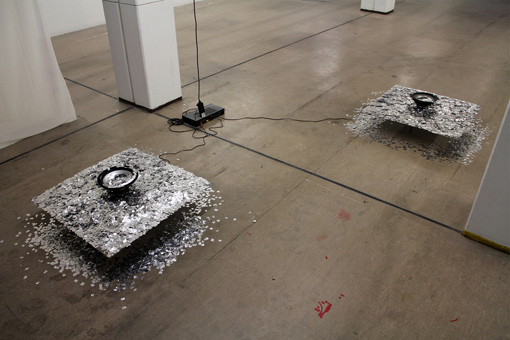
An extremly streched record of crackling aluminum shreds sets via speakers iron plates in motion.
The aluminium foil located on the plates starts to rustle and during the exhibiton time it is riplling down.
The two sound boards react apparently to another.
But there is also a suggestion to the viewer that he could influence the movement.
When I make my pieces I let the chosen material keep a life of it's own as far as possible. I don't force the material into a particular shape, which may not be innate to it, but still I create a new shape which may change it's original character to a certain extend.
By dissolving the usual shape of the material and by changing the material's aesthetics the tracing back to the original state of the material is made difficult. This makes it possible for the viewer to perceive my objects as a whole without immediately being able to define the material it is made of.
I always focus on the texture, surface, odor, as well as the color intensity of the material.
The titles are a crucial part of my pieces. The title tries to bring the objects into an almost narrative context. I realize which associations the title might evoke in the viewer just by confronting him with the material, the aesthetics and the title of a piece. Though I appreciate the fast that these associations do not become explicit but rather remain with the viewer during the act of viewing my work. The titles confuse the viewers eye and forces him to approach my pieces from a completely new angle.
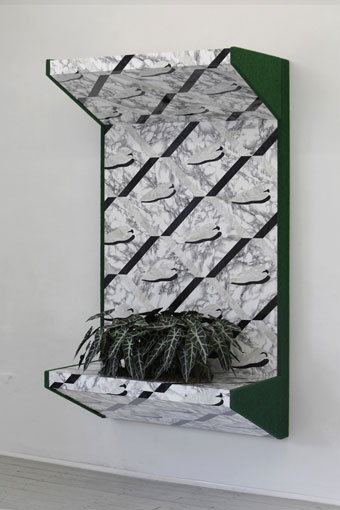
Maderthaner’s works, whether two- or three-dimensional, evolve according to a two-cycle logic: first synthesize, then sublimate. What the artist unearths in her environs—forms, textures, patterns and outer surfaces—are at first reduced, condensed and boiled down to the bone. DIY markets, allotment gardens, amateur-styled websites and laymen-designed flyers are her sources of inspiration, among others. This visual ornamentation is then, in a second phase, enriched with elements of minimalist sculpture or abstract graphics—whereby it is more a question of the codes of minimalist codes—a phase that undergoes further disassociation. Beyond all deconstructivist assertions or postmodern posturing, Maderthaner’s works are manifestly serious and autonomous with a touch of irritating matter-of-factness. (…)
Emmanuel Mir, 2014, Excerpt from “Out of the Deluge”
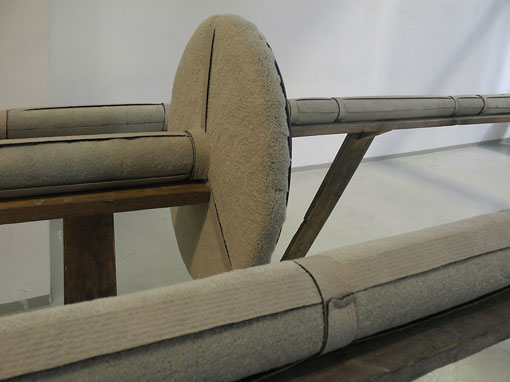
Schreckenberger resorts to personal circumstances and observations and blends these with fixed entities, that have matured in the collective consiousness. Therefore they are entities, that do not only grow in the mind of the artist. For the first source of form he searches within himself, for the second source he searches in his surrounding to canalise this while dreaming. Where the the two rivers unite the artist encounters archetypes. a pool of archetypes concerning universal combinations of form, that seldom become visible in their ideal coinage. These archetypes are aggloramations; they substantiate in a figure or a body, in various states, variations and moments of an object. They are independent of time, space and culture. They simply exist. They are the undeniable truth of unquestionable entities. They are evident.
Schreckenberger does not chase these archetypes. He leaves the door open wide enough for them to find the path into his hands. The reminiscence of the factual and substantial or well-directed finding of form is irrelevant for this process. The action is implicit, non-analytical, non-reflective. (…)
excerpt from the text „when the dream rises into hands“, Emmanuel Mir, 2014, (translation by Nora Hansen)
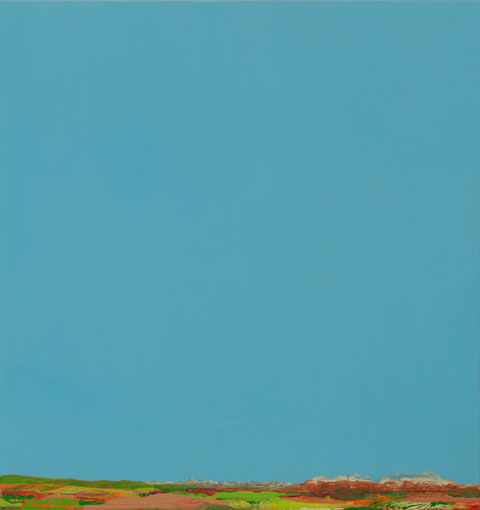
“The eyes follow the horizon, meandering between what is above and below.” Choosing her words carefully, Susanne Maurer says all that needs to be said about her works, at the same time providing very precise instructions on how to look at her paintings. Hers is no Abstract Expressionist colour field painting, for the horizon line to be found in almost all her works is bound to make us read them as landscapes. Sometimes the line is positioned so low down that the canvas is dominated by a dramatically orchestrated cloud-filled firmament. Elsewhere it is the other way round: the horizon is no more than a hand’s breadth below the upper edge of the canvas, below it a bird’s-eye view of a landscape (...). Window views, horizon lines, bird’s-eye or aerial perspectives – Susanne Maurer uses all these and more of the techniques, which since Vitruvius and Alberti have been part of the art theory toolbox and which enable us to read her works indubitably as landscapes.“ (Dr. Erich Schneider, Kunsthalle Schweinfurt)
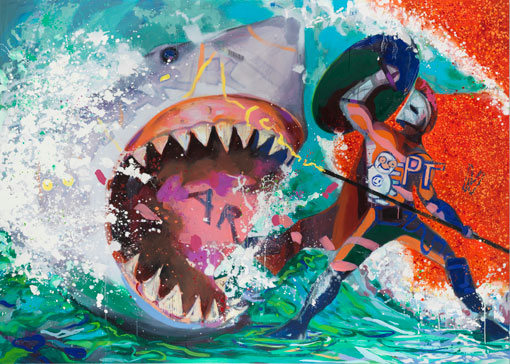
All of my paintings are related to the world of media. The original pictures are taken from the Internet, TV, newspapers, or magazines.
From these types of media we all know celebrities like politicians, actors, rock stars or even comic book characters. Their faces seem to be omnipresent and are part of our everyday life. Their images have been burnt into our collective archives. I’m not interested in this phenomenon as a sociologist or concept artist but as a painter. My work doesn’t mean copying and repeating media by simply depicting their pictures in paint. When painting I reflect on the translatability of well-known icons into painting. What do I need what can I delete? It’s a process of abstraction consisting of layers and shapes that often lead to an unforeseen result. Therefore you wouldn’t be able to compare my approach with that of a portrayer.
Not the personality of people and their individual or outstanding qualities are in my focus but simply their outer appearance and their recognition value.
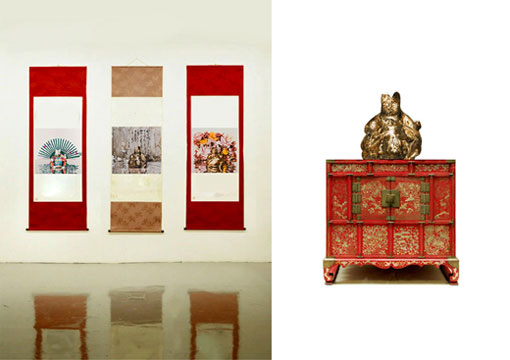
I'm interested in all kinds of images which could be defined as Orient. There is something old about them. An odd atmosphere which exist somewhere close to death. My interests came from small discoveries I made in daily life in Germany, in a vietnamise restaurants, thai massage shops, yoga classes, or the fact that tofu is very popular here as a well as being way of alternative food culture. The works I am presenting are results from my simple curiousity in why the Orient is reproduced repeatedly and adored by people today? What makes people to buy this shiny plastic Haneda Neko, the golden Japanese cat welcoming you in every sushi restaurant? It is an observation about what part of Orient is entertaining people
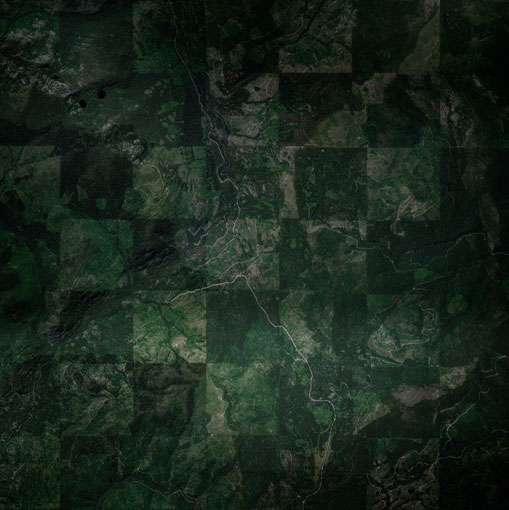
'Absent Presence'
This series of human altered aerial landscapes all over the world is based on dozens of screenshots taken from Google Earth, which are then stitched together to create ultra high resolution images. These images are then manipulated further to forge a stronger sense of depth and place and to evoke an atmosphere of solitude and detachement of their sourrounding
Being not created in the traditional sense of photography but rather fabricated and selectively choosen from hundreds and thousand of images taken via an automated process of multiple machines orbiting the earth's surface, the creators presence is no longer necessary from an otherwise highly inaccessible viewpoint.
The patterns visible in the images are marks of extensive agriculture and deforestation absent of any sign of human existens elsewhere.
Footprints and subaerial engravings of an absent presence.